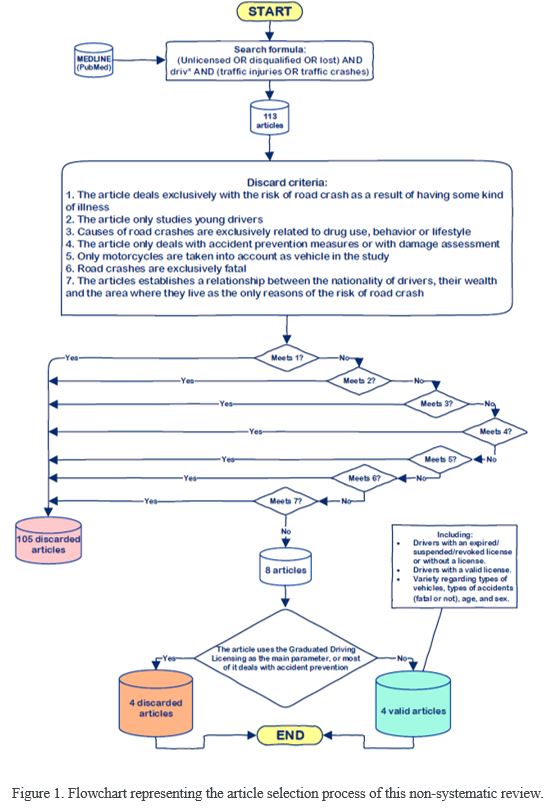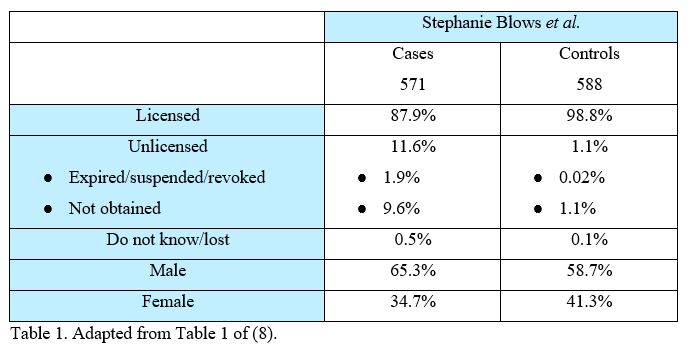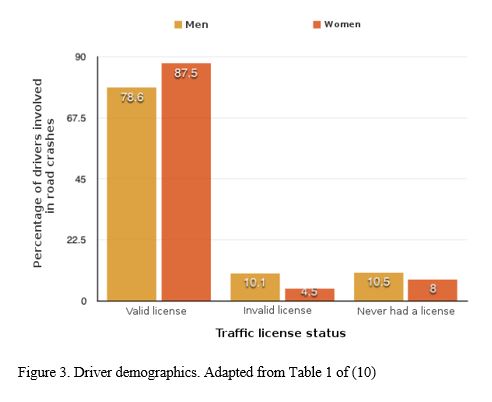Silvia Clares-Mena¹, Alejandro Fernández-Valverde¹, Rosa María Zumaquero-Pérez².
TRANSLATED BY:
Pablo Torregrosa-Parra³, Miguel Sillero-Romero³, Mario Sánchez-Cortés-Macías³, Ana Goás-Pérez³, Alicia Gómez-Patiño³, Julia González-Cuenca³.
- Faculty of Medicine, University of Granada (UGR).
- Faculty of Sciences (Biology), University of Granada (UGR).
- Faculty of Translation and Interpreting, University of Granada (UGR).
Research in this field over the years has suggested that road crashes are the reason behind numerous deaths per year worldwide. Studying all risk factors related to these accidents reveals the considerable importance of the human factor. Alcohol, speeding, physiological state or failure to use safety measures are the most important, but the validity of the driving license is studied to a lesser extent. This is why this non-systematic review of the literature is conducted. A statistically significant relationship between expired, suspended or revoked driving licenses and accident risk was found. In addition, this review revealed that the risk of road crash among unlicensed drivers is closely linked to other sort of human factors, mainly alcohol, drug use and speeding. Sex and age have been important demographic parameters in studies, concluding that men and young people are more likely to drive without a valid license.
Keywords: driving license, accident, sex, young people, unlicensed drivers, drivers.
Palabras clave: licencia de conducción, accidentalidad, sexo, jóvenes, sin licencia, conductores.
INTRODUCTION
Road crashes are included within the injuries of external cause and are defined as a generally involuntary event caused, at least, by a vehicle in motion that damages people and goods involved in it. This affects the traffic flow of vehicles on the roads involved or within the area of influence of the road crash (1).
According to the World Health Organization, road crashes are the cause of 1.3 million deaths worldwide each year. In addition, they are the leading cause of death among children and young people aged 5-29 years. These two data bring to light very worrying figures, which are even higher if we take into account that 93% of the deaths related to road crashes happen in middle and low-income countries (2). As for Spain, there were 37,892 injury accidents and 1,195 fatal accidents in 2018 (3). Most research on road crashes in Europe is focused on the causes of these accidents. These can be either human (e.g. alcohol consumption, drug use, physiological state while driving or speeding), mechanical or climatic. However, there is not enough research on the validity of driving licenses as a human risk factor in victims of road crashes (4). On the other hand, in the United States and Australia there are more published articles on license status as a cause of the accidents (5).
Therefore, a non-systematic review to study the effect of driving without a valid license on the risk of causing a road crash was conducted. As a matter of clarification, not having a valid license or being an unlicensed driver involves: (1) people who have never obtained their driving license, (2) those whose driving license has been suspended or revoked for violating traffic regulations, (3) or those whose driving license has expired.
METHODS
An international non-systematic review of articles published in the MEDLINE database through the open access search engine PubMed was performed.
The aim of this review was to check whether there is a relationship between driving license status and road crashes. To this end, the study population was those drivers who drove on roads with an expired, suspended or revoked driving license, or who had no license. This population was compared with drivers who did have a valid driving license. In this way, a relationship between the illegitimate use of the driving license and the potential risk of road crashes was established. As mentioned above, the approach to the literature search was based on retrieving articles dealing with the relationship between the risk of road crashes and driving license status. For this purpose, the focus was on two factors when selecting the articles: (1) to include unlicensed drivers in the study, and (2) to include studies where the rate of road crashes in a region is related to the validity of the driving license.
The selection of articles was carried out following these criteria: their date of publication was delimited to the last 15 years (2005-2020), and no search filters were applied regarding the language, because it was considered that this review would have an international scope. The keywords used to search the articles were chosen following the terminology thesaurus MeSH (Medical Subject Headings), and they were chosen freely according to our study hypothesis. To streamline the search process in PubMed, a search formula was created: (Unlicensed OR disqualified OR lost) AND driv* AND (traffic injuries OR traffic crashes). This formula covers unlicensed drivers (study population), drivers in general (including drivers with a valid driving license, allowing the comparison with the study group), and road crashes, so that drivers can be related to the accident.
As a result, eight relevant documents were selected from the total of 113 references found. Although these eight documents included the desired parameters to deal with the hypothesis, three of them were discarded because they used as the main parameter the Graduated Driving Licensing (GDL), which did not fit our research question. Another article was discarded because it focused on solutions that could be applied to prevent unlicensed driving. Finally, we focused on the four remaining articles, which were the basis of this non-systematic review (5, 8-10) (Figure 1).

RESULTS
The actual prevalence of unlicensed drivers in the general population and the risk of being involved in a road crash are unknown. However, some studies appear to suggest that unlicensed drivers are more likely to be involved in road crashes, and these tend to be more serious.
According to studies carried out in some countries, a considerable part of road crashes is caused by unlicensed drivers. Australia and the US estimate that unlicensed drivers are involved in 10-20% of fatal accidents (6).
In addition, according to data by Foundation for Traffic Safety (7), an unlicensed driver is involved in one out of five fatal accidents in the US. The risk of road crash is higher for those who never obtained a driving license compared to those whose license had been revoked. Nevertheless, in Europe there is a lack of studies on unlicensed drivers and their involvement in road crashes (5).
Some studies, such as the one carried out by Stephanie Blows et al. (8), investigated the prevalence of unlicensed drivers among those who had had a road crash and had been hospitalized or had passed away (cases), in comparison with people who were driving in the same area and had not had an accident (controls).
In the interview with the drivers, several factors, such as driving license status, alcohol, the state of the vehicle, the Stanford Sleepiness Scale, the speed of the vehicle, and seat belt use were considered. Adjusting for sex and age, a strong association between unlicensed drivers and fatal crashes was found, since 12% of cases did not possess a driving license as opposed to 1% of controls (Table 1). The article concluded that, in terms of road crashes, unlicensed drivers represented a statistically significant risk group up to three times as high compared to licensed drivers. Other risk factors and possible confounders were also analyzed, with ethnicity, educational level, Stanford Sleepiness Scale, alcohol and time of driving exposure being the ones contributing most likely to being involved in a fatal crash. Furthermore, it was observed that unlicensed drivers presented risky driving behaviors, such as alcohol consumption, speeding or not wearing a seat belt, thus increasing the risk of road crash, the possibilities of being found guilty, and being involved in more serious road crashes. It should be considered in this article that the controls not answering the survey might also be unlicensed drivers, which would lead to overestimate the number of drivers without a valid driving license in the cases group.

Therefore, there are other documents that present data supporting these ideas, such as the one conducted by Sukhvir S. Brar (9). The data in this study were obtained from the road crash databases known as Fatality Analysis Reporting System (FARS) and Statewide Integrated Traffic Records System (SWITRS). The first database reports on licensed drivers, whereas the second one reports on the guilt of the drivers involved in the road crash. The factors considered for this study were the date and time of the accident, the age and sex of the driver and the model year of the vehicle. The accidents selected were those where two vehicles were involved (passenger cars or light trucks) with identified drivers having a valid or revoked driving license, or not having one. The accidents where two people or none were guilty were discarded.
It was observed that the prevailing age group in this type of accidents ranged from 20 to 29 years. Those unlicensed drivers crashing tended to be younger than those with a valid driving license. Furthermore, those with a revoked or suspended license or those who did not possess one were twice as involved in road crashes as those with a valid license. Their fatality relative risk ratio was higher than 1 (2.6 for those with a revoked or suspended driving license, and 2.7 for those without license) in all years analyzed.
With regard to the higher propensity to be involved in a fatal road crash among young people without a valid driving license, some data were also found in the study by Jonathan Fu et al. (10). In this paper, variables such as the license status, sex of the passenger, alcohol consumption, number of passengers, year of the accident and whether it took place in an urban or rural area were studied. It concluded that young drivers (25-34 years old) without driving license are often involved in a higher number of fatal crashes and present certain risk behaviors (e.g. drug and alcohol abuse, speeding, and a lower seat belt use). Among the victims, 10.51% were unlicensed and 8.8% had an expired license (Table 2).

It should be noted that these drivers also play an important role in the safety behavior of their passengers. This study showed that the use of a safety system such as the seat belt by the driver is a predictor of its use by the passengers (10) (some of these data are collected in Table 2). It is thus concluded that driving without a license represented a statistically significant risk for the absence of use of the passenger restraint system. It was also observed that the presence of a young female passenger in the vehicle led to safer driving practices by young male drivers, whereas a young male passenger was associated with more dangerous driving practices for both male and female drivers (10).
Finally, the study conducted by Friduly Sagberg (5) concluded that, in accordance with the results of previous work, unlicensed drivers face a higher risk of road crash (3%) than other drivers (1.4%), in addition to being of a more serious magnitude. Speeding, drug use, alcohol consumption and recklessness are more frequent among unlicensed drivers and among those responsible for the accident both with or without a license. Alcohol or drug influence was found in 50% of unlicensed drivers, compared to 17% of licensed drivers.
DISCUSSION
According to one of the studies used as a reference (8), drivers with an expired license are twice as likely to have initiated the accident. Despite their coincidences in several factors, we found differences both in sample sizes and in the duration of the studies (8, 9).
There is a strong association among unlicensed drivers between negligence committed based on age and sex (5, 8-10). Road crash rate is higher among young people, specifically between 15 and 39 years of age (9) (Figure 2). Nevertheless, there were no significant associations in other studies (8) between the license status and the age demographic variable due to the small size of the sample used for the study. Furthermore, it was shown that men are more likely to drive without a valid driving license than women (9) (Figure 2).


As argued in one of the studies (8), it is unlikely that driving without a license increases per se the risks of suffering injuries due to road crashes, as this is probably due to its association with other factors. Among the factors that can affect accident rate along with an expired driving license, the authors agree that alcohol and drug use are the main causes (8, 9). Sleepiness, speeding and seat belt use should also be noted (5, 8-10). With regard to the factors mentioned, a sex distinction concerning seat belt use is made, with women tending to wear it more, which is in turn related to safer driving practices in comparison with men – all that based on the age demographic factor, specifically among young people (10).
Regarding all the parameters measured in the documents of interest, there are barely any contradictions between the results of the studies. All of them agree on the existence of an association between road crash rates and the illegitimate use of driving licenses. Therefore, it can be concluded that unlicensed drivers are more involved in road crashes than licensed drivers (5, 8-10). Nevertheless, this non-systematic review presents some limitations, as it focused on a very specific research question. As a consequence, we were obliged to exclude studies not fulfilling the selection criteria. As mentioned at the beginning, there are differences in sample size and duration between studies, which does not allow for certain parameters to be measured in some of them. As a result, a comparison under the same conditions cannot be established. Furthermore, the restriction of articles on this study hypothesis to specific geographical areas renders the results obtained not completely representative on a global scale.
CONCLUSIONS
Road crashes are a well-studied event all over the world. The numerous studies on the field identify alcohol, bad state of the car, speeding or age as clear risk factors leading to an accident while driving. Among these factors, one that is not as well explored as the rest is worth mentioning: the validity of the driving license.
When conducting this non-systematic review, a small number of studies analyzing the connection between road crashes and the possession of a driving license was identified. The articles found on this last risk factor show as a first remarkable fact that almost all of them were carried out in the United States or Australia, and very few in Europe. According to the study hypothesis and its literature search, this makes the results obtained not completely representative on a global scale. In addition to this, all concluded that driving without a valid driving license is directly associated with higher accident rates. This situation is usually linked to other types of negligent behavior, such as alcohol consumption, speeding or failure to use vehicle safety measures. Likewise, among unlicensed drivers, the profile of the young male driver stands out.
In view of this non-systematic review and the results obtained in it, it can be concluded that, due to the scarcity of research on the main topic (especially in Europe), it is necessary to design new studies collecting new data to analyze the relationship examined and subsequently extrapolate the results to a global scale.
STATEMENTS:
Acknowledgements
This paper is part of the Teaching Innovation Project coordinated between the Faculty of Medicine and the Faculty of Translation and Interpreting of the University of Granada (UGR), within the framework of the FIDO Plan 2018-2020 of the UGR (code 563).
Ethical concerns
This paper did not require the approval of any ethics committee.
Conflicts of interest
The authors of this paper declare no conflicts of interest.
Funding
No funding was received for the production of this paper.
REFERENCES
(1) mintransporte.gov.co [Internet]. Ministerio de Transporte, Gobierno de Colombia; [Last access: 24 March 2020]. Available at: https://www.mintransporte.gov.co/preguntas-frecuentes/4/seguridad-vial—accidentes-de-transito/
(2) who.int [Internet]. World Health Organization; [Last access: 9 March 2020]. Available at: https://www.who.int/es/news-room/fact-sheets/detail/road-traffic-injuries
(3) dgt.es [Internet]. Dirección General de Tráfico; [Last access: 24 March 2020]. Available at: http://www.dgt.es/es/seguridad-vial/estadisticas-e-indicadores/accidentes-30dias/tablas-estadisticas/2018/
(4) Hanna CL, Hasselberg M, Laflamme L, Möller J. Road traffic crash circumstances and consequences among young unlicensed drivers: A Swedish cohort study on socioeconomic disparities. BMC Public Health. 2010;10.
(5) Sagberg F. Characteristics of fatal road crashes involving unlicensed drivers or riders: Implications for countermeasures. Accid Anal Prev.2018; 117:270-5.
(6) Watson B. The Crash Risk of Disqualified/Suspended and Other Unlicensed Drivers. In International Conference on Alcohol, Drugs and Traffic Safety [Internet]. 200.p. Available at: https://eprints.qut.edu.au/7002/
(7) Griffin LI, Delazerda S.Unlicensed to Kill.2000.
(8) Blows S, Ivers RQ, Connor J, Ameratunga S, Woodward M, Norton R. Unlicensed drivers and car crash injury. Traffic Inj Prev.2005;6(3):230-4.
(9) Brar SS. Estimating the over-involvement of suspended, revoked, and unlicensed drivers as at-fault drivers in California fatal crashes. J Safety Res. 2014; 50:53-8.
(10) Fu J, Anderson CL, Dziura JD, Crowley MJ, Vaca FE. Young unlicensed drivers and passenger safety restraint use in u.s. Fatal crashes: concern for risk spillover effect? Ann Adv Automot Med. 2012; 56:37-43.
AMU 2020. Volumen 2, Número 1
Fecha de envío: Fecha de aceptación: Fecha de publicación:
16/03/2020 06/04/2020 29/05/2020
Cita el artículo: Clares-Mena S, Fernández-Valverde A, Zumaquero-Pérez R.M. El riesgo potencial de accidentes de tráfico debido al uso ilegítimo del permiso de conducción. AMU. 2020; 2(1): 34-49
